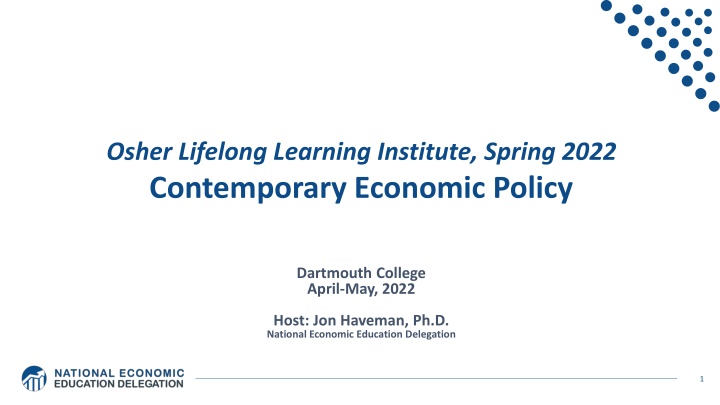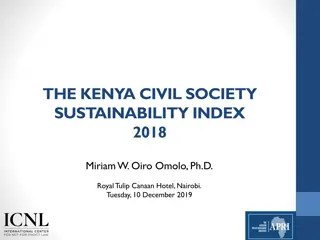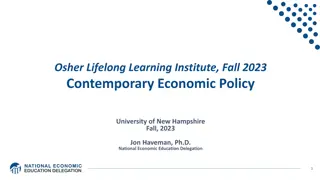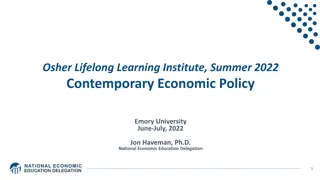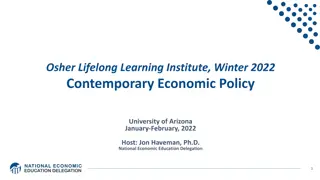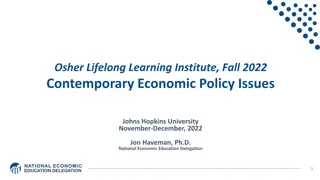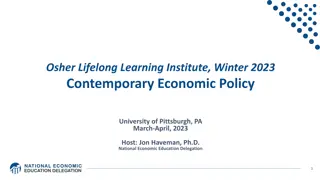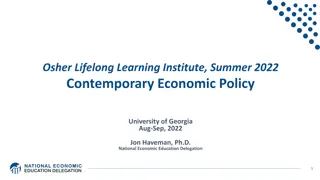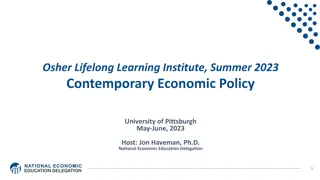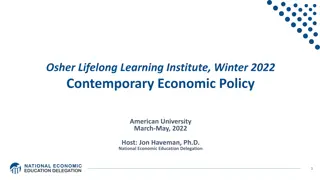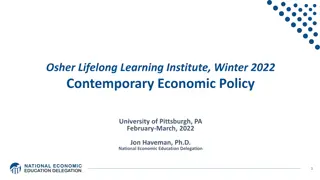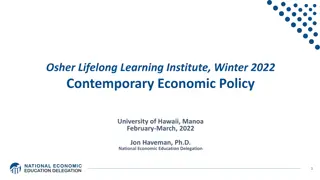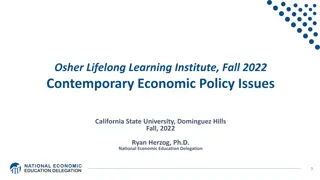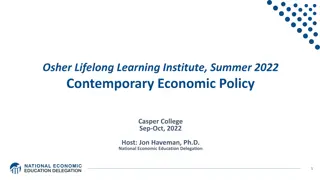Contemporary Economic Policy at Osher Institute
Dive into the Spring 2022 program on Contemporary Economic Policy at Dartmouth College's Osher Lifelong Learning Institute. Explore intriguing topics like US Economy, Trade, Wealth Gap, Federal Debt, and more. Engage with expert hosts and guest speakers, and get ready for insightful discussions on pressing economic issues. Stay updated with the course outline and submit your questions for in-depth learning. Join this educational journey to enhance your knowledge of economic policies.
Download Presentation

Please find below an Image/Link to download the presentation.
The content on the website is provided AS IS for your information and personal use only. It may not be sold, licensed, or shared on other websites without obtaining consent from the author.If you encounter any issues during the download, it is possible that the publisher has removed the file from their server.
You are allowed to download the files provided on this website for personal or commercial use, subject to the condition that they are used lawfully. All files are the property of their respective owners.
The content on the website is provided AS IS for your information and personal use only. It may not be sold, licensed, or shared on other websites without obtaining consent from the author.
E N D
Presentation Transcript
Osher Lifelong Learning Institute, Spring 2022 Contemporary Economic Policy Dartmouth College April-May, 2022 Host: Jon Haveman, Ph.D. National Economic Education Delegation 1
Available NEED Topics Include: Coronavirus Economics Immigration Economics US Economy Housing Policy Climate Change Federal Budgets Economic Inequality Federal Debt Economic Mobility Black-White Wealth Gap Trade and Globalization Autonomous Vehicles Minimum Wages US Social Policy 2
Course Outline Contemporary Economic Policy - Week 1 (4/18): US Economy & Russia/Ukraine Conflict - Week 2 (4/25): Trade and Globalization (Alan Deardorff, University of Michigan) - Week 3 (5/2): The Black-White Wealth Gap (Jon Haveman, NEED) - Week 4 (5/9): Federal Debt (Brian Peterson, Central College) - Week 5 (5/16): Autonomous Vehicles (Jon Haveman, NEED) - Week 6 (5/23): Economic Mobility (Kathryn Wilson, Kent State University) 3
Submitting Questions Please submit questions of clarification in the chat. - I will try to handle them as they come up. We will do a verbal Q&A once the material has been presented. OLLI allowing, we can stay beyond the end of class to have further discussion. Slides will be available from the NEED website tomorrow (https://needelegation.org/delivered_presentations.php) 4
Economic mobility Kathryn Wilson, Ph.D. Kent State University May 2, 2022 <location/audience> <date> 5
Credits and Disclaimer This slide deck was authored by: - Oana Tocoian, UCSD - Kathryn Wilson, Kent State University - Jon Haveman, NEED Disclaimer - NEED presentations are designed to be nonpartisan. - It is, however, inevitable that the presenter will be asked for and will provide their own views. - Such views are those of the presenter and not necessarily those of the National Economic Education Delegation (NEED). 6
Outline I. What do we mean by economic mobility? II. Empirical patterns of economic mobility III. What is the desirable level of economic mobility? IV. Exploring channels/barriers to upward mobility and policy options 7
I. What do we mean by economic mobility? Definition and motivation 8
I. What do we mean by economic mobility? Economic Mobility Defined Economic Mobility Our working definition: - Ability to advance beyond the status of your parents. Variety of measures: - Income - Wealth - Education level - Occupation - Home ownership More Broadly: The ability to improve your socioeconomic class. We will consider intergenerational mobility in INCOME. 9
I. What do we mean by economic mobility? Absolute and Relative Mobility - Absolute mobility: the difference in income from one s parent. - You re higher on the escalator than your parents were. - It is possible for everyone to experience upward absolute mobility, especially if the escalator is going up. - Relative mobility: the change in income rank from one s parent. - You have fewer people above you on the escalator than your parents did. - Increased relative mobility requires both upward and downward movement. 10
I. What do we mean by economic mobility? More on Absolute vs Relative Mobility Can there be absolute mobility with NO relative mobility? - Yes: if everybody experiences the same increase in income, there will be no relative income. Can there be relative mobility with NO absolute mobility? - Yes: There can be a dramatic reshuffling of the distribution even if there is no increase in average income. Parents Kids Parents Kids +2 -1 +1 -2 11
I. What do we mean by economic mobility? Economic Growth and Mobility Economic growth should drive absolute mobility - It has the potential to raise all incomes. - But the extent of mobility that results depends on how income is distributed. Economic growth and relative mobility are unrelated - Growth does not have implications whether kids are more or less likely to rise above their parent s position in the income distribution. 12
II. Empirical patterns of Economic Mobility What are the facts? 13
II. Empirical Patterns of Economic Mobility Mobility Big Picture for Absolute Mobility Decline in absolute mobility in the United States: - 90% of those born in the early 1940s could expect to earn more than their parents in real terms. For millennials, the fraction is closer to 50% - Below-median earnings have not increased in real terms since the 1970s. 14
II. Empirical Patterns of Economic Mobility 9 out of 10 of those born in the early 1940s could expect to earn more than their parents 1 in 2 Millennials (born after 1980) earn more than their parents. 15
II. Empirical Patterns of Economic Mobility Absolute Mobility by Birth Cohort 94% 93% 88% 70% 45% 33% 16
II. Empirical Patterns of Economic Mobility American Dream: Geography Matters Trends in Absolute Mobility by State: Change from 1940-1980 Decline in Abs. Mob. from 1940-80 17 https://opportunityinsights.org/paper/the-fading-american-dream/
II. Empirical Patterns of Economic Mobility Absolute Mobility: Race 18
II. Empirical Patterns of Economic Mobility Absolute Mobility: Gender 19
II. Empirical Patterns of Economic Mobility Measuring Relative Mobility Reminder: Relative mobility is the change in income rank from one s parent. Transition Probabilities: Likelihood that an individual ends up in a different income quintile than their parents. Perfect Equality: For each of the parental income quintiles, 20% of their offspring end up in each income quintile as adults. 20
II. Empirical Patterns of Economic Mobility Transition Probabilities in the United States 21 https://www.brookings.edu/wp-content/uploads/2016/06/11_generations_isaacs.pdf
II. Empirical Patterns of Economic Mobility Transitions: International Comparisons Source: : https://equitablegrowth.org/research-paper/are-todays-inequalities-limiting-tomorrows-opportunities 22
II. Empirical Patterns of Economic Mobility American Dream: Geography Matters 23 https://www.brookings.edu/blog/social-mobility-memos/2018/01/11/raj-chetty- in-14-charts-big-findings-on-opportunity-and-mobility-we-should-know/
II. Empirical Patterns of Economic Mobility Relative Mobility: Race 24
II. Empirical Patterns of Economic Mobility Relative Mobility: Gender 25
II. Empirical Patterns of Economic Mobility Summary of Empirical Patterns Absolute economic mobility in the United States has been in decline since the 1940s - Half of people born in the mid-1980s have not outperformed their parents in terms of income Relative mobility is lower in the United States than many developed countries - Income is especially sticky at the bottom and the top of the income distribution Geography matters there is tremendous variation in mobility within the United States There are racial differences (large) and gender differences (smaller) in absolute and relative mobility. 26
III. What is the desirable level of economic mobility? Economically what is optimal? What do people think is optimal? Mobility and Inequality 27
III. What is the Desirable Level of Economic Mobility Absolute or Relative Mobility? - Upward absolute mobility of the whole population is unambiguously desirable (it s hard to defend not wanting everyone to be better off!) The fact that half the population is treading water should worry us. - But, relative mobility is a zero-sum game: for some people to rank higher than their parents did, others have to rank lower. 28
III. What is the Desirable Level of Economic Mobility The Right Level of Relative Mobility Efficiency - Want to provide incentives in order to get economic growth Equity - Want a system that is fair What is the optimal level of relative mobility? This is a hard question, one which we may not be able to answer or agree on. Is current relative mobility too low (or too high)? The answer would suggest the best incremental steps to take towards a better outcome, and policy changes are best done in incremental steps in any case. 29
III. What is the Desirable Level of Economic Mobility How is the Mobility Porridge? How might we answer the second question (is mobility too low/ too high)? - Common sense judgement - E.g. is it plausible that due to merit alone a child from the top 1% would be 77 times as likely to attend an Ivy League school than a child from the bottom quintile? What if the likelihood was 5-fold? - Forget merit: is it wise for a society to exclude large segments of the population from the circles of its future leaders? - Examination of the channels through which relative mobility can occur, how they relate to family resources and how they respond to investigative changes (see next section) 30
III. What is the Desirable Level of Economic Mobility Survey Says on Upward Mobility from the BOTTOM https://www.brookings.edu/blog/social-mobility-memos/2016/01/12/how-much-social-mobility-do-people-really-want/
III. What is the Desirable Level of Economic Mobility Survey Says on Downward Mobility from the TOP https://www.brookings.edu/blog/social-mobility-memos/2016/01/12/how-much-social-mobility-do-people-really-want/
III. What is the Desirable Level of Economic Mobility Preferences hit Awkward Truth: Math Again: relative mobility is a zero-sum game - There are only so many spots in the top quintile (only 20% of population can be there) o Preferences want: 43% of them for kids born into the top 16% for those born into the bottom Leaves about 14% for each of the other 3 quintiles o Preferences are inconsistent Greater upward mobility for the bottom than the middle? Results are intuitive: - Stickiness at the top - Mobility from the bottom but inconsistent: - What about the middle? 33
III. What is the Desirable Level of Economic Mobility Public Perception and Sentiment Perception: American Dream vs Old World - General belief is that the U.S. has greater mobility than elsewhere. o Fewer explicit barriers no nobility titles. o More meritocratic rags to riches , Heratio Alger o The American Dream plays a significant part in national identity. Reality: Overestimate of actual mobility - Common perception is incorrect. 34
III. What is the Desirable Level of Economic Mobility The American Dream Shapes Perceptions 35 https://www.brookings.edu/wp-content/uploads/2016/06/02_economic_mobility_sawhill.pdf
III. What is the Desirable Level of Economic Mobility Mobility and Inequality Less mobility may have normative implications about the desired level of inequality More inequality makes both absolute and relative mobility more difficult 36
Peru More Mobility Less Mobility China Brazil Germany U.S. Canada 37 https://equitablegrowth.org/research-paper/are-todays-inequalities-limiting-tomorrows-opportunities
IV. Exploring channels/barriers to upward mobility and policy options Focus on Education and Career Opportunities 38
IV. Exploring Channels/Barriers to Upward Mobility and Policy Options Barriers to Upward Mobility Key Question: What are the factors that might prevent someone born in a low-income household from doing as well as their richer counterpart? Answers: - Birth Lottery - Structural barriers 39
IV. Exploring Channels/Barriers to Upward Mobility and Policy Options Barriers to Upward Mobility Birth Lottery Early advantages - Innate (genetic) advantages: o Inherited ability, medical conditions, psychological traits - Environmental factors: o In utero: pre-natal care, mother s nutrition, exposure to abuse or stress. o Home environment which promotes healthy development, transmission of family values o Availability of role models, mentors, neighborhood effects. o Availability of good educators, facilities, peers 40
IV. Exploring Channels/Barriers to Upward Mobility and Policy Options Barriers to Upward Mobility Structural Selective access to quality higher education - Preferential admission for legacy and donor families. - Expectation of extra-curricular activities, AP classes, etc. Effective access to family planning (sex ed, contraceptives, abortion) - Teen births reduce outcomes for both mother and child. Access to lucrative employment - Reliance on personal connections, homophily, racism, sexism... Access to entrepreneurship and invention - initial capital and insurance against negative shocks, social networks. Direct transmission of income-earning assets 41
IV. Exploring Channels/Barriers to Upward Mobility and Policy Options Education: an Avenue and Barrier to Mobility 42 https://www.brookings.edu/wp-content/uploads/2016/06/02_economic_mobility_sawhill.pdf
IV. Exploring Channels/Barriers to Upward Mobility and Policy Options College Attendance Rates by Parent s Income 100% Percent in College at 19 80% 60% 84-87 Slope = 0.745 40% (0.008) 20% 0 20 40 60 80 100 Parent Income Rank 43 https://opportunityinsights.org/paper/recentintergenerationalmobility/
IV. Exploring Channels/Barriers to Upward Mobility and Policy Options College Quality Rank by Parent s Income 80 Mean College Quality Rank 70 60 50 40 84-87 Coll. Qual Gradient (P75-P25) = 0.191 88-90 Coll. Qual Gradient (P75-P25) = 0.192 91-93 Coll. Qual Gradient (P75-P25) = 0.181 30 0 20 40 60 80 100 Parent Income Rank 1984-87 1988-90 1991-93 44 https://opportunityinsights.org/paper/recentintergenerationalmobility/
IV. Exploring Channels/Barriers to Upward Mobility and Policy Options Educational Mobility 45 https://www.brookings.edu/blog/social-mobility-memos/2014/10/27/the-inheritance-of-education/
IV. Exploring Channels/Barriers to Upward Mobility and Policy Options Career Opportunities: an Avenue and Barrier to Mobility Business Ownership Inventions Job Networks 46
IV. Exploring Channels/Barriers to Upward Mobility and Policy Options Career Opportunities Business Incorporation Ownership of a business is a big indicator of wealth accumulation Children from a wealthy family are more likely to incorporate a business 47 Graph from Sarada and Tocoian (2018)
IV. Exploring Channels/Barriers to Upward Mobility and Policy Options Career Opportunities employment networks 2 out of 3 sons of the top earners in Canada get access to their father s employer. Much less access at lower levels of parental earnings. 48
IV. Exploring Channels/Barriers to Upward Mobility and Policy Options Career Opportunities Inventions High math-ability 3rd graders go on to become inventors if their family is well-off. (Also if they grow up in high- innovation areas) 49 Graph from Bell et al (2018)
IV. Exploring Channels/Barriers to Upward Mobility and Policy Options Policy Options Investments in education - Make preparedness for college more universally available. Entrepreneurship - Introduce children to it at an early age and seek to reduce barriers to starting a business. Housing vouchers, public housing, zoning laws - Help underprivileged children grow up in neighborhoods conducive to mobility. Implement policies to reduce inequality. 50
